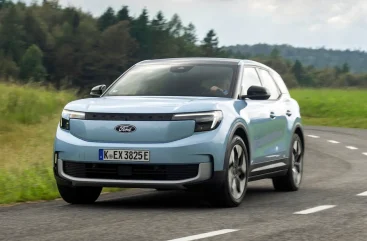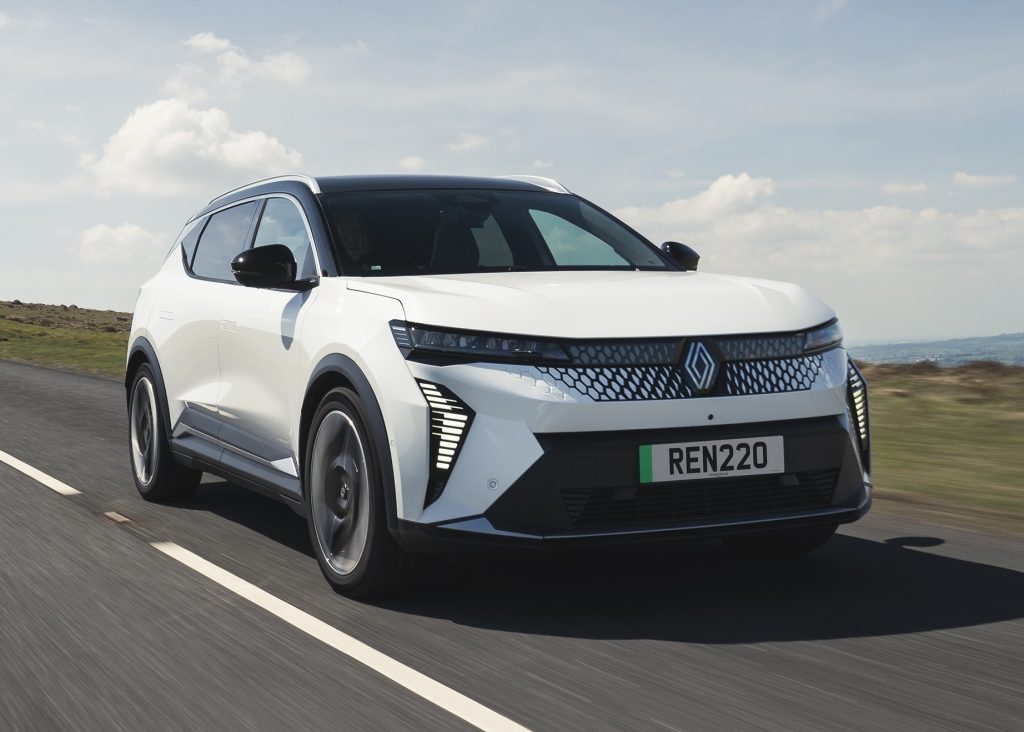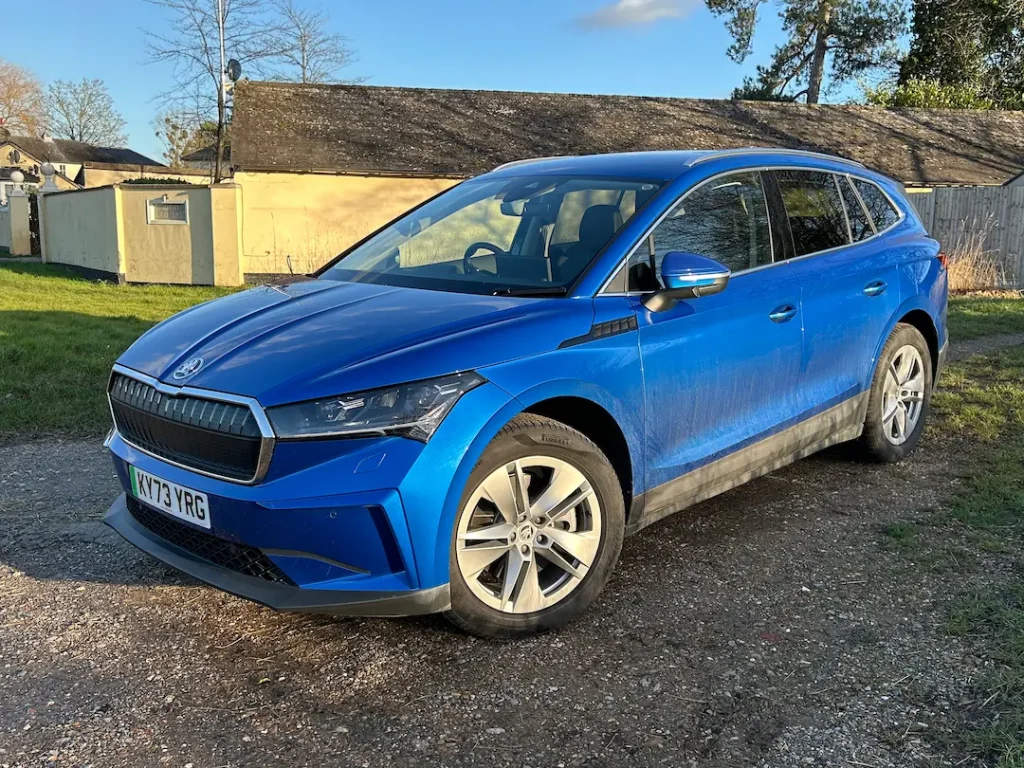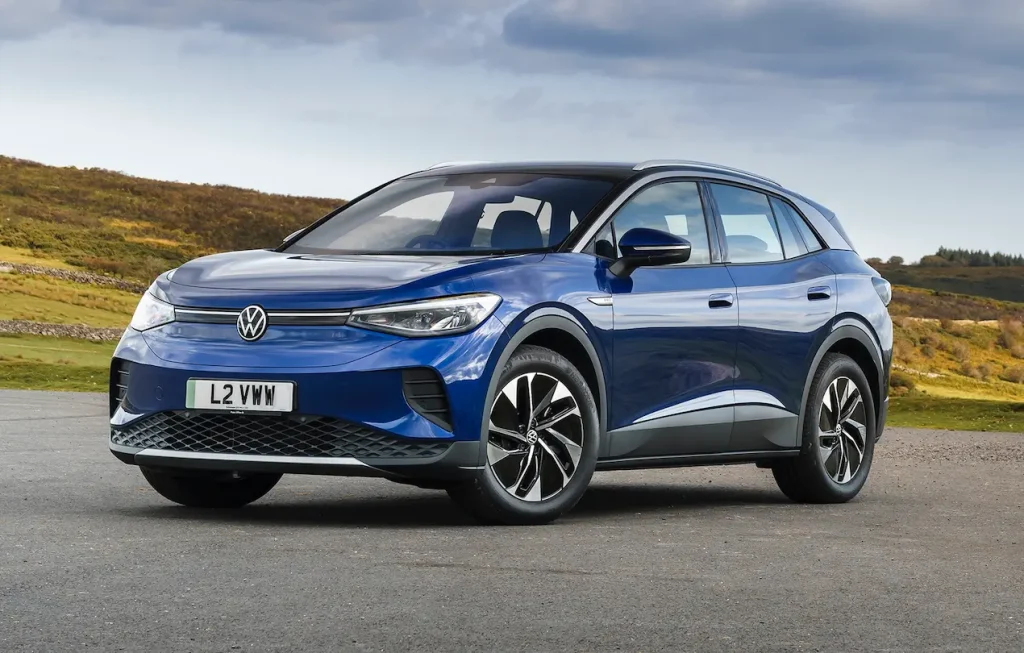
Ford Explorer
Two billion pounds, that’s what Ford has been very keen to tell us has been invested in the 100-year-old Cologne plant alone, where the new Explorer and incoming Capri will be built.
All-new to Ford, but underpinning the Explorer is a modified version of Volkswagen’s MEB EV platform. Probably closest to the VW ID.4 (which we’re also looking at in this comparison) in terms of size, they share a similar wheelbase – but the Explorer is 116mm shorter overall. Most of that’s lopped from the rear, equalling the 470-litre boot – which is 70-odd-litres down on the ID.4, it’s smaller than the Renault Scenic that we’re also covering here, too.
Inside things get better for the Ford, as it feels roomy – much the same as the ID.4 unsurprisingly! The Explorer’s interior also scores high for stowage, and includes the clever ‘Megaconsole’, 17 litres of stowage space under the front central armrest. Plus, there’s also a lockable storage space behind the infotainment screen for valuables.
Talking of the Explorer’s central 14.6in touchscreen, it’s sharp, responsive, but running Ford’s Sync Move software which is a problem. Why? Well, some icons are too small, and you can’t always find your way out of menus easily.
Elsewhere, this Ford EV’s driving position is fine and includes a supportive, electrically adjustable driver’s seat with massage function. Move to the boot, and on the plus side, it has no load lip, a height-adjustable floor, 60/40-split rear seats, and a ski hatch.
Interior build quality is the equal of the ID.4, but in our opinion, the Explorer looks smarter. There are harder plastics, like the top of the dashboard, but your eye isn’t drawn to them.
As you’d expect from a Ford, the Explorer is a good drive. With light, but accurate steering, Ford tuned passive suspension (there’s no adaptive option), to make the Explorer more agile than the Volkswagen – it’s succeeded. It turns in eagerly and contains body lean well.
At slow speeds on patchy town roads, the ride is noticeably fidgety. Although this improves the faster you go, but you’ll notice some background shimmy at motorway speeds through the seat and steering wheel.
But the drive is only part of what this Explorer is about. Company car drivers are going to be keener on the 2% BIK charge, 0 g/km emissions, and its 374-mile range. Sadly, the Ford is kicked into third place here with the second-highest depreciation (£25,935).
Read more: Ford Explorer review
| Model | Ford Explorer Select 77kWh |
| P11D | £45,820 |
| CO2 (tax) | 0g/km (2%) |
| BIK 20/40% a month | £15/£30 |
| Range | 374 miles |
| National Insurance | £10.53 |
| First year VED | £0 |
| Subsequent VED | £0 |
| Battery size/power | 77kWh/286hp |
| AFR | 7p |
| Residual value | 45% |
| Depreciation | £25,935 |
| Fuel costs | £3,598 |
| SMR | £3,321 |
| Cost per mile | 53.09p |

Renault Scenic E-Tech
The Scenic nameplate is back on a Renault, but this time it is being sold as a crossover. Yet despite this, the French manufacturer is selling the Scenic on the roominess and practicality of its interior. One interior highlight is the SolarBay roof, which can be changed from clear to opaque at the touch of a button, or by voice command.
This Scenic is in range-topping Iconic spec, with the second-highest P11D figure in this group (£45,440), and unsurprisingly, it has affected its standing – but it remains similar to the other models here in terms of price.
More impressive, considering the other models in this set, is the fact that at £21,250 and 47%, it has the highest residuals. On top of this, the Scenic is the lowest depreciator at £23,490. Where the Renault falls down, is that it has the highest predicted electricity cost, at £3,869 – so that raises questions of efficiency. However, with its high residuals and low depreciation, the Scenic achieves the lowest cost per mile figure here.
Read more: Renault Scenic E-Tech review
| Model | Renault Scenic E-Tech Iconic 87kWh |
| P11D | £45,440 |
| CO2 (tax) | 0g/km (2%) |
| BIK 20/40% a month | £15/£30 |
| Range | 379 miles |
| National Insurance | £10.49 |
| First year VED | £0 |
| Subsequent VED | £0 |
| Battery size/power | 87kWh/215hp |
| AFR | 7p |
| Residual value | 47% |
| Depreciation | £23,490 |
| Fuel costs | £3,869 |
| SMR | £2,561 |
| Cost per mile | 49.86p |

Skoda Enyaq
Our current favourite medium SUV sits on the same new MEB EV platform as the Ford Explorer and the VW ID.4. The Enyaq has received significant drivetrain, battery, and infotainment upgrades this year.
Additionally, 85 versions replace the previous 80. With power up to 282hp, 0-62mph acceleration takes 6.7 seconds – yet because of the optimised battery, the range jumps to an impressive 348 miles. And it can be charged at up to 135kW – although the entry-level 60 is unchanged.
Skodas tend to perform well when it comes to residuals, but the eye-opener here, is that at 43%, the Enyaq performs better than its German sister car the ID.4 at 36%! Although it can’t topple the Ford or Renault, at 45% and 47% respectively. The Skoda doesn’t have the best residuals of this set, but it’s one of the slowest depreciators with its £24,925 figure behind the Renault at £23,490.
Read more: Skoda Enyaq review
| Model | Skoda Enyaq 85 Edition 82kWh |
| P11D | £44.485 |
| CO2 (tax) | 0g/km (2%) |
| BIK 20/40% a month | £14/£29 |
| Range | 348 miles |
| National Insurance | £10.24 |
| First year VED | £0 |
| Subsequent VED | £0 |
| Battery size/power | 82kWh/286hp |
| AFR | 7p |
| Residual value | 43% |
| Depreciation | £24,925 |
| Fuel costs | £3,759 |
| SMR | £2,825 |
| Cost per mile | 52.15p |

Volkswagen ID.4
The ID.4 is Volkswagen’s first EV SUV and the second model from its ID electric family. Like the Enyaq, the ID.4 is a practical SUV in the same vein as the Explorer. Match is the entry-level spec, but we’ve chosen the bigger, 77kWh version, which is more competitive against the others in the set. Standard equipment is still decent, with 19in alloy wheels, heated front seats, an electrically operated tailgate, climate windscreen, rear tinted glass, keyless entry and starting, together with a rear-view camera.
Our ID.4 is powered by the Pro 77kWh battery, this equals 349 miles of range and 201hp. This Volkswagen is easy and good to drive.
The ID.4 might be the cheapest to buy of this set, but at 36%, it has the lowest residual value, and the highest depreciation at £27,730. The ID.4 doesn’t have the longest range, but on the flip side, it does have the second-lowest National Insurance (NI) monthly figure at £10.45, but this isn’t enough for the Volkswagen to not finish in a disappointing last position here.
| Model | Volkswagen ID.4 Match Pro 77kWh |
| P11D | £44.305 |
| CO2 (tax) | 0g/km (2%) |
| BIK 20/40% a month | £14/£29 |
| Range | 349 miles |
| National Insurance | £10.19 |
| First year VED | £0 |
| Subsequent VED | £0 |
| Battery size/power | 77kWh/286hp |
| AFR | 7p |
| Residual value | 36% |
| Depreciation | £27,730 |
| Fuel costs | £3,856 |
| SMR | £2,850 |
| Cost per mile | 57.42p |





